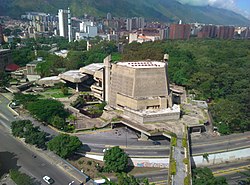粗野主义
| 粗野主义 | |
|---|---|
| 年份 | 全球(1950-1970年代) |
粗野主义(英語:Brutalism,又称蠻橫主義或粗犷主义)是一種起源於1950年代英國的建筑风格[1][2][3][4][5],主要興起於戰後重建項目,特別在戰後的共產主義國家中廣泛使用而聞名。被視為建築流派的一種,可歸入现代主义建筑流派當中,其特色包括由功能主义發展而來的極簡主義結構,突顯出建筑材料和结构工程的裸露,避免裝飾性設計。[6][7]此風格常使用未塗漆的钢筋混凝土或磚[8][7],呈現角形幾何形狀和主要單色調色板,同時還使用其他材料如鋼材、木材和玻璃等。[9]
粗獷主義的起源源自現代主義運動,被視為對1940年代建築懷舊情感的反應[10]。該詞最早由英國建築師艾莉森和彼得史密森的計畫和理論著作提出,用於形容他們對設計的創新方法。建築評論家雷納·班漢姆在1955年進一步推廣了這一運動,將其與法語:béton brut(清水混凝土)和法語:art brut(非主流藝術)聯繫。[11][12]最早使用法語:béton brut一詞的是柯比意,用來指稱強化混凝土。[13][14]隨後,粗獷主義主由史密森夫婦、匈牙利出生的埃爾諾·戈德芬格、英國的查姆伯林·鮑威爾和邦建築公司等建築師發展,有時與其他現代主義建築師的作品相呼應,如法國-瑞士的勒·柯布西耶、愛沙尼亞-美國的路易斯·康、德國-美國的路德維希·密斯·凡德羅和芬蘭的阿尔瓦尔·阿尔托等人。[7][15]
在英國,粗獷主義受到社会主义原則影響的實用、低成本公營住宅的設計中得到體現,並迅速傳播到世界其他地區,尤其是東歐[16][6][7][17]。粗獷主義的設計最常見於機構建築,如省議會、公共工程項目、大學、圖書館、法院和市政廳。這一運動的流行在20世紀70年代末開始下降,有些人將其與都市衰退和極權主義聯繫在一起。粗獷主義在社會主義和共產主義國家中的流行,歸因於將傳統風格與資產階級聯想在一起,而混凝土則強調平等。[18]
歷史上,粗獷主義的評價有著多個分歧;部分特定建築以及整個運動都受到一系列批評(通常被描述為『冷漠』或『無靈魂』),但也得到了建築師和當地社區的支持,近幾十年來,這一運動再次引起了人們的興趣。2006年,一些波士頓建築師呼籲將這一風格重新定位為「英勇建築」,以擺脫「粗獷」這一術語的負面含義。[19]同時許多粗獷建築已成為文化偶像,獲得了受保護的地位。
歷史
這一詞彙最早由瑞典建築師漢斯·阿斯普隆德(Hans Asplund)所起,以描述烏普薩拉的建築“Villa Göth”(1950年建成)。當時他所用的是瑞典語“nybrutalism”(新粗野主義),後來迈克尔·文特里斯等英格蘭建築師也埰用了這一名稱。其概念在英国的史密森夫妇(Alison & Peter Smithson)手上得到進一步發展[20][21]。建築評論家雷納·班海姆在1966年出版《The New Brutalism: Ethic or Aesthetic?》一書,使得這個詞彙流傳開。[21]
勒·柯布西耶是粗野主义最著名的代表人物,代表作品有马赛公寓和印度昌迪加尔法院。这些建筑用当时还少见的混凝土预制板直接相接,没有修饰,预制板没有打磨,甚至包括安装模板的销钉痕迹也还在。
受“粗野主义”影响的还有英国的詹姆斯·斯特林爵士(莱汉姆住宅)、美国的保罗·鲁道夫(耶鲁大学建筑系馆)、美国的路易·康(李查醫學研究中心)、德国的哥特佛萊德·伯姆、日本的前川国男(京都文化会馆、东京文化会馆)及其学生丹下健三(山梨县文化会馆)等人。
在前蘇聯國家的建築師中,設計這種建築不單單是為了藝術,而是因為共產黨為了應付大量建設需求,產生了政治意味濃厚的赫鲁晓夫楼所致,成為了社會主義影響地區的主要風格。
亞洲例子
参考文献
- ^ Reclaiming Polish Brutalism: Discover the Emblems of Communism. ArchDaily. 28 October 2018 [18 October 2023]. (原始内容存档于2023-11-05) (美国英语).
- ^ Larsson, Naomi. Socialist modernism: remembering the architecture of the eastern bloc. The Guardian. 6 August 2023 [18 October 2023]. ISSN 0261-3077. (原始内容存档于2024-03-04) (英国英语).
- ^ Definition of BRUTALISM. www.merriam-webster.com. [2019-07-11]. (原始内容存档于2023-11-08) (英语).
- ^ Bull, Alun, What is Brutalism?, 8 November 2013 [10 October 2018], (原始内容存档于2023-11-08)
- ^ Đorđe, Alfirević & Simonović Alfirević, Sanja: Brutalism in Serbian Architecture: Style or Necessity? (页面存档备份,存于互联网档案馆) Facta Universitatis: Architecture and Civil Engineering (Niš), Vol. 15, No. 3 (2017), pp. 317–331.
- ^ 6.0 6.1 Hopkins, Owen. The Dezeen guide to Brutalist architecture. Dezeen. 10 September 2014 [19 April 2020]. (原始内容存档于2024-03-07).
- ^ 7.0 7.1 7.2 7.3 Editorial Staff. Brutalist architecture - a retrospective. Architecture and Design. [19 April 2020]. (原始内容存档于2023-11-08).
- ^ Brutalist Architecture London | A Guide To Brutalism. 20 Bedford Way. 2014-06-23 [2020-05-11]. (原始内容存档于2023-09-20) (英国英语).
- ^ Harwood, Elain. The concrete truth? Brutalism can be beautiful. BBC Arts. [11 May 2020]. (原始内容存档于2023-12-04).
- ^ Rasmus Wærn. Guide till Sveriges Arkitektur : Byggnadskonst Under 1000 År. Stockholm: Arkitektur Förlag. 2001. ISBN 9789186050559.
- ^ 引用错误:没有为名为
:0的参考文献提供内容 - ^ Snyder, Michael. The Unexpectedly Tropical History of Brutalism. The New York Times. 15 August 2019 [11 May 2020]. (原始内容存档于2022-04-06).
- ^ The architectural term ‘brutalism’ didn’t come from ‘brutal.’ Here’s its origin.. washingtonpost. 2017-06-17 [2024-01-26]. (原始内容存档于2020-02-15).
- ^ Brutalism: Revival of a raw beauty. Allplan Website. 2018-01-16 [2024-01-26]. (原始内容存档于2024-01-26).
- ^ A Movement in a Moment: Brutalism | Architecture | Agenda. Phaidon. [2020-05-11]. (原始内容存档于2023-10-12).
- ^ Andrei, Mihai. Brutalist architecture and its unusual, raw appeal. ZME Science. 15 May 2022 [18 October 2023]. (原始内容存档于2024-01-14) (美国英语).
- ^ Plitt, Amy. The history of Brutalist architecture in NYC affordable housing. Curbed NY. 11 November 2019 [30 April 2020]. (原始内容存档于2023-11-09) (英语).
- ^ Levanier, Johnny. Brutalism in design: its history and evolution in modern websites. 99designs. [2023-11-26]. (原始内容存档于2022-08-15).
- ^ Byrnes, Mark. The Case for Calling Brutalism 'Heroic' Instead. Bloomberg.com. 25 November 2015 [2020-06-01]. (原始内容存档于2020-06-07) (英语).
- ^ Meades, Jonathan. The incredible hulks: Jonathan Meades' A-Z of brutalism. The Guardian. 13 February 2014 [11 March 2014]. (原始内容存档于2021-03-29).
- ^ 21.0 21.1 Golan 2003, p.3 (页面存档备份,存于互联网档案馆).
- Romy Golan, Historian of the Immediate Future: Reyner Banham – Book Review (页面存档备份,存于互联网档案馆), The Art Bulletin June 2003, Retrieved 29 December 2014
外部連結
- BRUTALISM:ONLINE (页面存档备份,存于互联网档案馆),記錄世界各地的粗野主義建築
- "The incredible hulks: Jonathan Meades' A-Z of Brutalism" (页面存档备份,存于互联网档案馆)
- From Here to Modernity (页面存档备份,存于互联网档案馆)
- "Bunkers, Brutalism and Bloodymindedness" 2-part BBC Documentary (页面存档备份,存于互联网档案馆)
- "Symbols in Transition" Documentary film regarding the post-89 handling of the political symbols and buildings of eastern Europe (页面存档备份,存于互联网档案馆)
- "The New Brutalism" Brutalist, Rationalist, Modernist architectural photography[永久失效連結]
- Ontario Architecture: Brutalism (页面存档备份,存于互联网档案馆)
- Google Community "Architecture of Brutalism" – many current photographs and links (页面存档备份,存于互联网档案馆)
| |||||||||||||||||||||||||||||||||||||||||||||||||||||||||||||||||||||||||||||||||||||||||||||
| ||||||||||||||||||||||||||||||||||||||||||||||
Text is available under the CC BY-SA 4.0 license; additional terms may apply.
Images, videos and audio are available under their respective licenses.








